2006 DODGE RAM SRT-10 engine
[x] Cancel search: enginePage 3784 of 5267
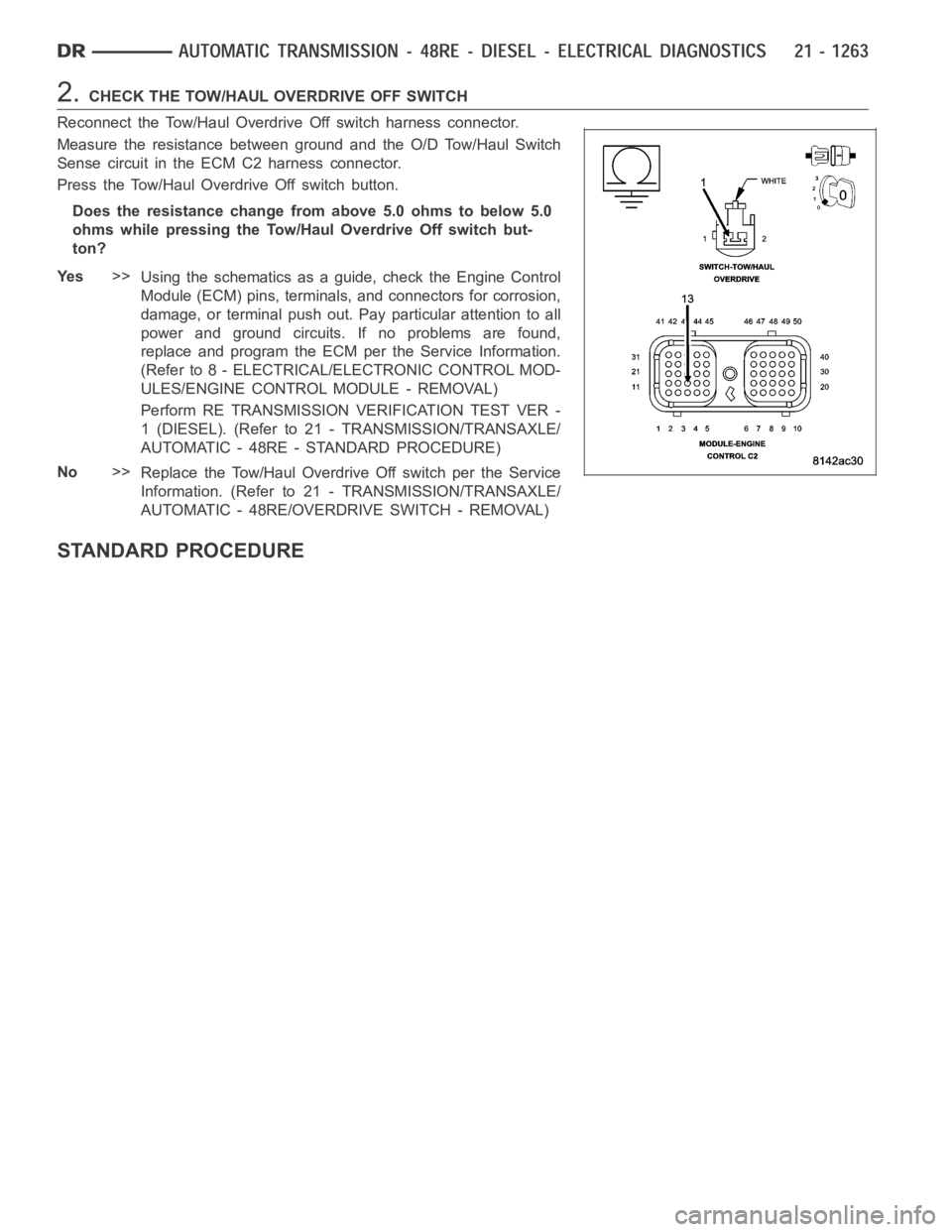
2.CHECK THE TOW/HAUL OVERDRIVE OFF SWITCH
Reconnect the Tow/Haul Overdrive Off switch harness connector.
Measure the resistance between ground and the O/D Tow/Haul Switch
Sense circuit in the ECM C2 harness connector.
Press the Tow/Haul Overdrive Off switch button.
Does the resistance change from above 5.0 ohms to below 5.0
ohms while pressing the Tow/Haul Overdrive Off switch but-
ton?
Ye s>>
Using the schematics as a guide, check the Engine Control
Module (ECM) pins, terminals, and connectors for corrosion,
damage, or terminal push out. Pay particular attention to all
power and ground circuits. If no problems are found,
replace and program the ECM per the Service Information.
(Refer to 8 - ELECTRICAL/ELECTRONIC CONTROL MOD-
ULES/ENGINE CONTROL MODULE - REMOVAL)
Perform RE TRANSMISSION VERIFICATION TEST VER -
1 (DIESEL). (Refer to 21 - TRANSMISSION/TRANSAXLE/
AUTOMATIC - 48RE - STANDARD PROCEDURE)
No>>
Replace the Tow/Haul Overdrive Off switch per the Service
Information. (Refer to 21 - TRANSMISSION/TRANSAXLE/
AUTOMATIC - 48RE/OVERDRIVE SWITCH - REMOVAL)
STANDARD PROCEDURE
Page 3785 of 5267
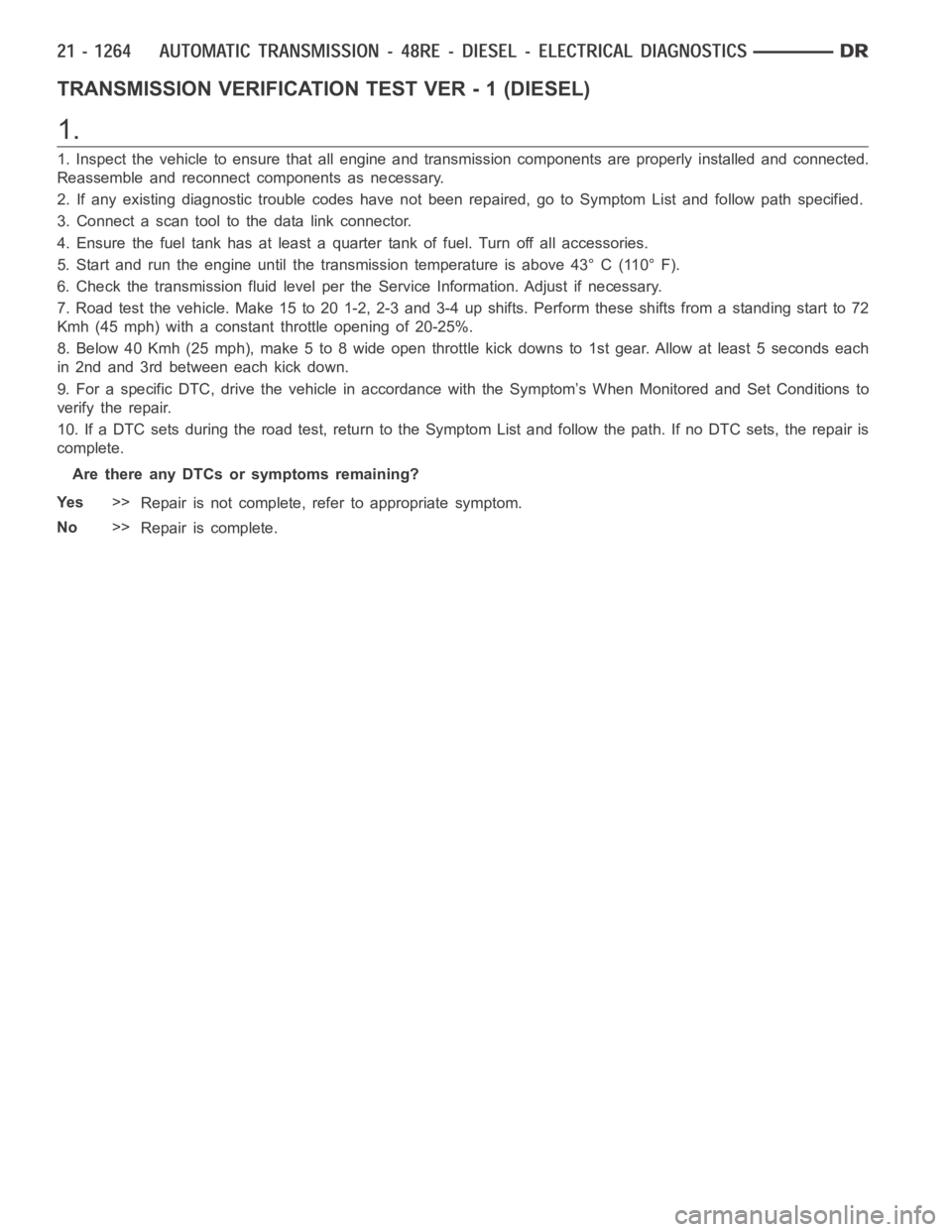
TRANSMISSION VERIFICATION TEST VER - 1 (DIESEL)
1.
1. Inspect the vehicle to ensure that all engine and transmission components are properly installed and connected.
Reassemble and reconnect components as necessary.
2. If any existing diagnostic trouble codes have not been repaired, go to Symptom List and follow path specified.
3. Connect a scan tool to the data link connector.
4. Ensure the fuel tank has at least a quarter tank of fuel. Turn off all accessories.
5. Start and run the engine until the transmission temperature is above 43°C(110°F).
6. Check the transmission fluid level per the Service Information. Adjustif necessary.
7. Road test the vehicle. Make 15 to 20 1-2, 2-3 and 3-4 up shifts. Perform these shifts from a standing start to 72
Kmh (45 mph) with a constant throttle opening of 20-25%.
8. Below 40 Kmh (25 mph), make 5 to 8 wide open throttle kick downs to 1st gear.Allow at least 5 seconds each
in 2nd and 3rd between each kick down.
9. For a specific DTC, drive the vehicle in accordance with the Symptom’s When Monitored and Set Conditions to
verify the repair.
10. If a DTC sets during the road test, return to the Symptom List and follow the path. If no DTC sets, the repair is
complete.
Are there any DTCs or symptoms remaining?
Ye s>>
Repair is not complete, refer to appropriate symptom.
No>>
Repair is complete.
Page 3786 of 5267

PRE-DIAGNOSTIC CHECKOUT (DIESEL)
For a complete wiring diagramRefer to Section 8W
1.PRE-DIAGNOSTIC CHECKOUT
NOTE: Always perform diagnostics with a fully charged battery to avoid false symptoms.
NOTE: Low fluid level can be the cause of many transmission problems. If thefluid level is low locate and
repair the leak then check and adjust the fluid level per the Service Information.
With the scan tool, read engine DTC’s. Check and repair all engine DTCs prior to performing transmission symptom
diagnostics.
Using the wiring diagram/schematic as a guide, inspect the wiring and connectors. Repair as necessary.
Verify the flash level of the Engine Control Module. Some problems are corrected by software upgrades.
Check for any Service Information Tune-ups or Technical Service Bulletins that may apply.
Did any of the above checks or procedures correct the symptom?
Ye s>>
Repair is complete.
Perform RE TRANSMISSION VERIFICATION TEST VER - 1 (DIESEL). (Refer to 21 - TRANSMISSION/
TRANSAXLE/AUTOMATIC - 48RE - STANDARD PROCEDURE)
No>>
Refer to the Transmission category and perform the appropriate symptom(s).
Page 3788 of 5267
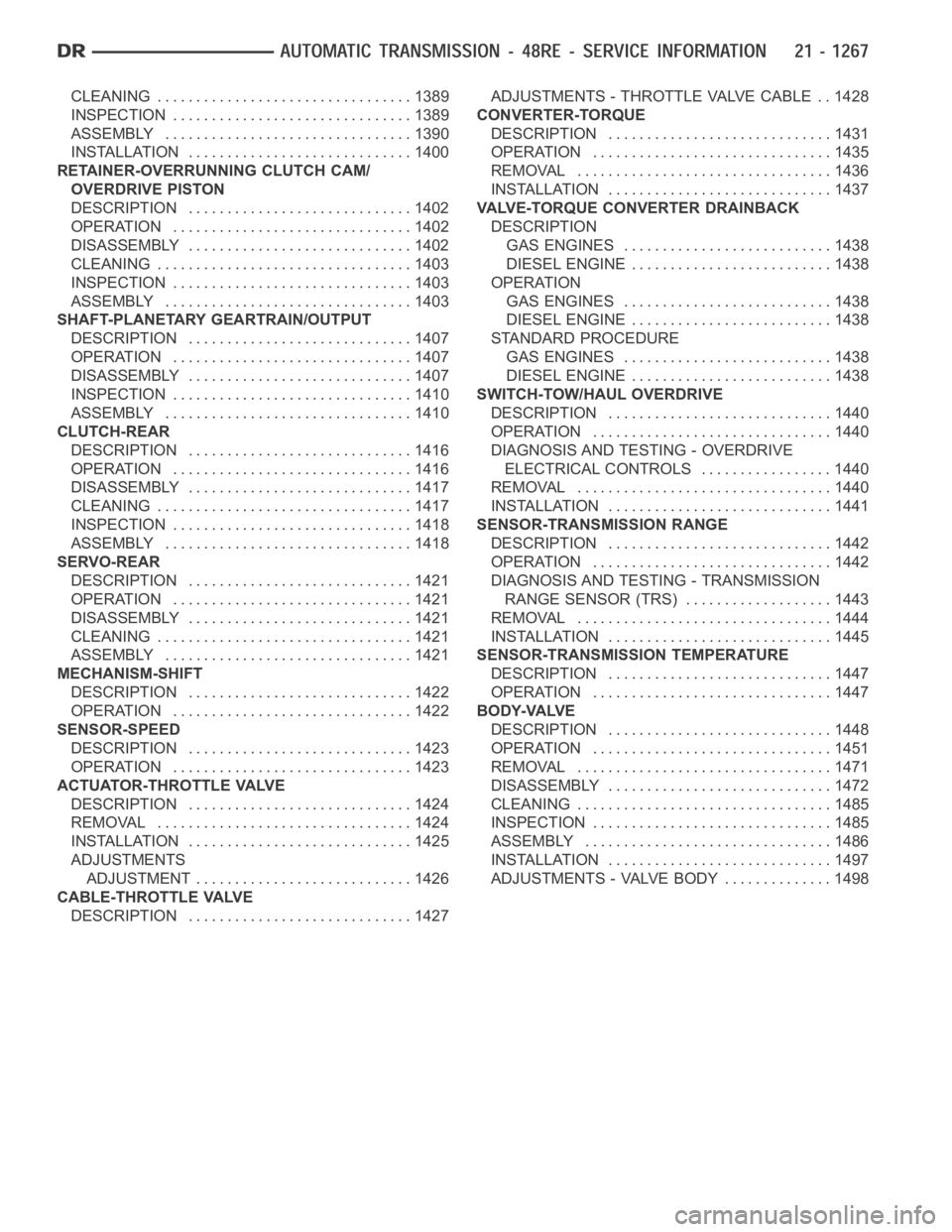
CLEANING ................................. 1389
INSPECTION ............................... 1389
ASSEMBLY . ............................... 1390
INSTALLATION ............................. 1400
RETAINER-OVERRUNNING CLUTCH CAM/
OVERDRIVE PISTON
DESCRIPTION ............................. 1402
OPERATION ............................... 1402
DISASSEMBLY ............................. 1402
CLEANING ................................. 1403
INSPECTION ............................... 1403
ASSEMBLY . ............................... 1403
SHAFT-PLANETARY GEARTRAIN/OUTPUT
DESCRIPTION ............................. 1407
OPERATION ............................... 1407
DISASSEMBLY ............................. 1407
INSPECTION ............................... 1410
ASSEMBLY ................................ 1410
CLUTCH-REAR
DESCRIPTION ............................. 1416
OPERATION ............................... 1416
DISASSEMBLY ............................. 1417
CLEANING ................................. 1417
INSPECTION ............................... 1418
ASSEMBLY ................................ 1418
SERVO-REAR
DESCRIPTION ............................. 1421
OPERATION ............................... 1421
DISASSEMBLY ............................. 1421
CLEANING ................................. 1421
ASSEMBLY ................................ 1421
MECHANISM-SHIFT
DESCRIPTION ............................. 1422
OPERATION ............................... 1422
SENSOR-SPEED
DESCRIPTION ............................. 1423
OPERATION ............................... 1423
ACTUATOR-THROTTLE VALVE
DESCRIPTION ............................. 1424
REMOVAL ................................. 1424
INSTALLATION ............................. 1425
ADJUSTMENTS
ADJUSTMENT ............................ 1426
CABLE-THROTTLE VALVE
DESCRIPTION ............................. 1427ADJUSTMENTS - THROTTLE VALVE CABLE . . 1428
CONVERTER-TORQUE
DESCRIPTION ............................. 1431
OPERATION ............................... 1435
REMOVAL ................................. 1436
INSTALLATION ............................. 1437
VALVE-TORQUE CONVERTER DRAINBACK
DESCRIPTION
GAS ENGINES ........................... 1438
DIESEL ENGINE .......................... 1438
OPERATION
GAS ENGINES ........................... 1438
DIESEL ENGINE .......................... 1438
STANDARD PROCEDURE
GAS ENGINES ........................... 1438
DIESEL ENGINE .......................... 1438
SWITCH-TOW/HAUL OVERDRIVE
DESCRIPTION ............................. 1440
OPERATION ............................... 1440
DIAGNOSIS AND TESTING - OVERDRIVE
ELECTRICAL CONTROLS ................. 1440
REMOVAL ................................. 1440
INSTALLATION ............................. 1441
SENSOR-TRANSMISSION RANGE
DESCRIPTION ............................. 1442
OPERATION ............................... 1442
DIAGNOSIS AND TESTING - TRANSMISSION
RANGE SENSOR (TRS) ................... 1443
REMOVAL ................................. 1444
INSTALLATION ............................. 1445
SENSOR-TRANSMISSION TEMPERATURE
DESCRIPTION ............................. 1447
OPERATION ............................... 1447
BODY-VALVE
DESCRIPTION ............................. 1448
OPERATION ............................... 1451
REMOVAL ................................. 1471
DISASSEMBLY ............................. 1472
CLEANING ................................. 1485
INSPECTION ............................... 1485
ASSEMBLY................................ 1486
INSTALLATION ............................. 1497
ADJUSTMENTS - VALVE BODY .............. 1498
Page 3791 of 5267
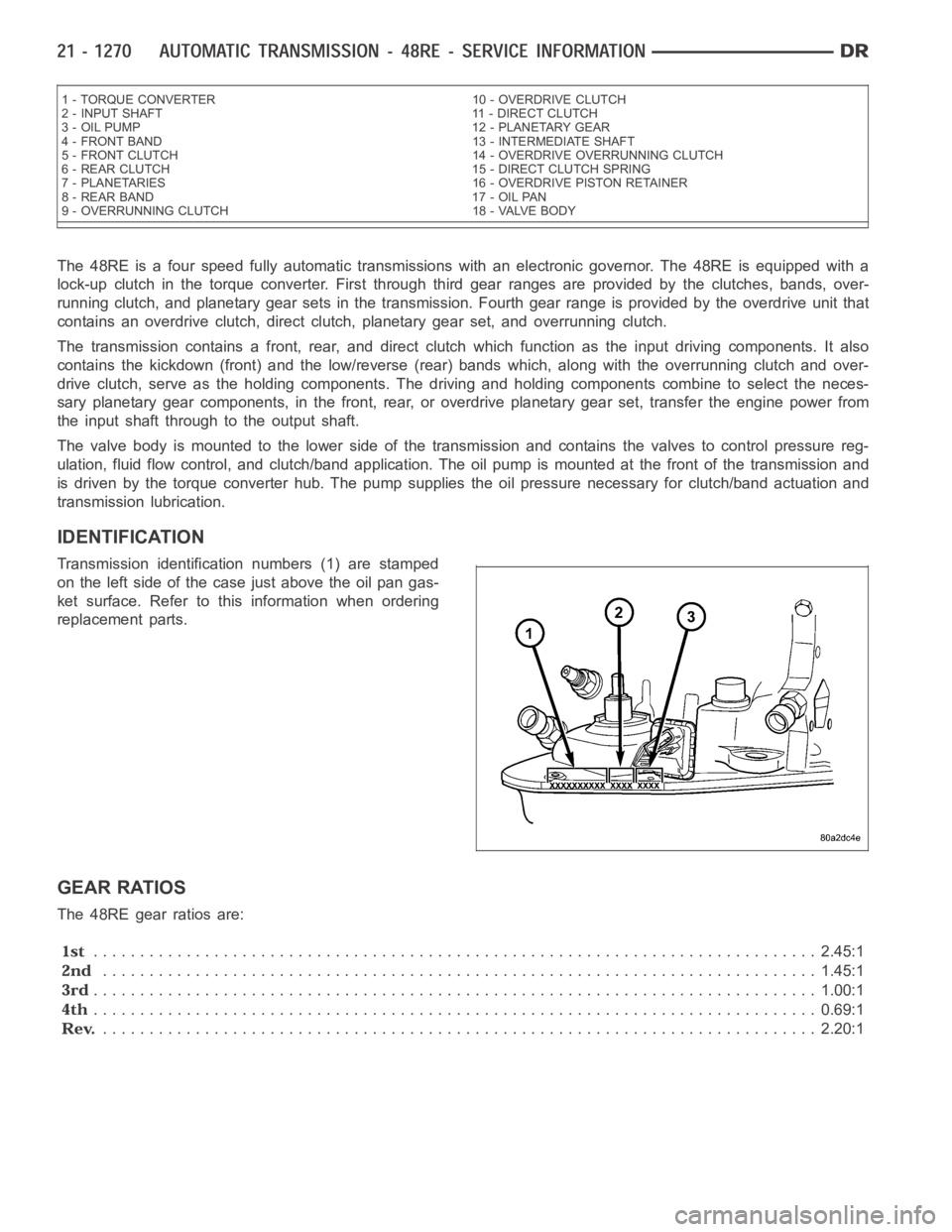
The 48RE is a four speed fully automatic transmissions with an electronic governor. The 48RE is equipped with a
lock-up clutch in the torque converter. First through third gear ranges are provided by the clutches, bands, over-
running clutch, and planetary gear sets in the transmission. Fourth gear range is provided by the overdrive unit that
contains an overdrive clutch, direct clutch, planetary gear set, and overrunning clutch.
The transmission contains a front, rear, and direct clutch which functionas the input driving components. It also
contains the kickdown (front) and the low/reverse (rear) bands which, along with the overrunning clutch and over-
drive clutch, serve as the holding components. The driving and holding components combine to select the neces-
sary planetary gear components, in the front, rear, or overdrive planetary gear set, transfer the engine power from
the input shaft through to the output shaft.
The valve body is mounted to the lower side of the transmission and containsthe valves to control pressure reg-
ulation, fluid flow control, and clutch/band application. The oil pump ismounted at the front of the transmission and
is driven by the torque converter hub. The pump supplies the oil pressure necessary for clutch/band actuation and
transmission lubrication.
IDENTIFICATION
Transmission identification numbers (1) are stamped
on the left side of the case just above the oil pan gas-
ket surface. Refer to this information when ordering
replacement parts.
GEAR RATIOS
The 48RE gear ratios are:
.............................................................................. 2.45:1
............................................................................. 1.45:1
.............................................................................. 1.00:1
.............................................................................. 0.69:1
............................................................................. 2.20:1
1 - TORQUE CONVERTER 10 - OVERDRIVE CLUTCH
2 - INPUT SHAFT 11 - DIRECT CLUTCH
3 - OIL PUMP 12 - PLANETARY GEAR
4 - FRONT BAND 13 - INTERMEDIATE SHAFT
5 - FRONT CLUTCH 14 - OVERDRIVE OVERRUNNING CLUTCH
6 - REAR CLUTCH 15 - DIRECT CLUTCH SPRING
7 - PLANETARIES 16 - OVERDRIVE PISTON RETAINER
8 - REAR BAND 17 - OIL PAN
9 - OVERRUNNING CLUTCH 18 - VALVE BODY
Page 3792 of 5267
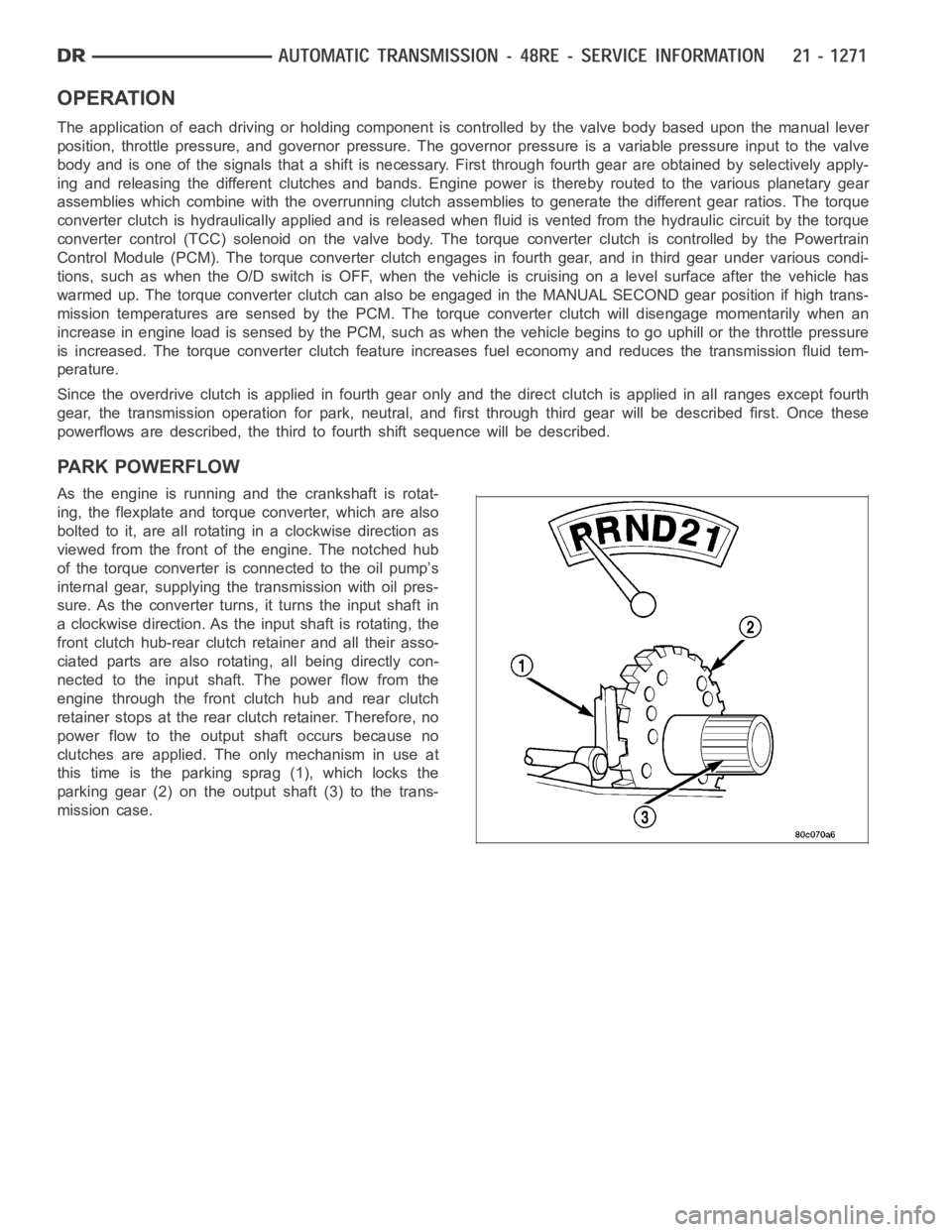
OPERATION
The application of each driving or holding component is controlled by the valve body based upon the manual lever
position, throttle pressure, and governor pressure. The governor pressure is a variable pressure input to the valve
body and is one of the signals that a shift is necessary. First through fourth gear are obtained by selectively apply-
ing and releasing the different clutches and bands. Engine power is thereby routed to the various planetary gear
assemblies which combine with the overrunning clutch assemblies to generate the different gear ratios. The torque
converter clutch is hydraulically applied and is released when fluid is vented from the hydraulic circuit by the torque
converter control (TCC) solenoid on the valve body. The torque converter clutch is controlled by the Powertrain
Control Module (PCM). The torque converter clutch engages in fourth gear,and in third gear under various condi-
tions, such as when the O/D switch is OFF, when the vehicle is cruising on a level surface after the vehicle has
warmed up. The torque converter clutch can also be engaged in the MANUAL SECOND gear position if high trans-
mission temperatures are sensed by the PCM. The torque converter clutch will disengage momentarily when an
increase in engine load is sensed by the PCM, such as when the vehicle beginsto go uphill or the throttle pressure
is increased. The torque converter clutch feature increases fuel economyand reduces the transmission fluid tem-
perature.
Since the overdrive clutch is applied in fourth gear only and the direct clutch is applied in all ranges except fourth
gear, the transmission operation for park, neutral, and first through third gear will be described first. Once these
powerflows are described, the third to fourth shift sequence will be described.
PARK POWERFLOW
As the engine is running and the crankshaft is rotat-
ing, the flexplate and torque converter, which are also
bolted to it, are all rotating in a clockwise direction as
viewed from the front of the engine. The notched hub
of the torque converter is connected to the oil pump’s
internal gear, supplying the transmission with oil pres-
sure. As the converter turns, it turns the input shaft in
a clockwise direction. As the input shaft is rotating, the
front clutch hub-rear clutch retainer and all their asso-
ciated parts are also rotating, all being directly con-
nected to the input shaft. The power flow from the
engine through the front clutch hub and rear clutch
retainer stops at the rear clutch retainer. Therefore, no
power flow to the output shaft occurs because no
clutches are applied. The only mechanism in use at
this time is the parking sprag (1), which locks the
parking gear (2) on the output shaft (3) to the trans-
mission case.
Page 3794 of 5267
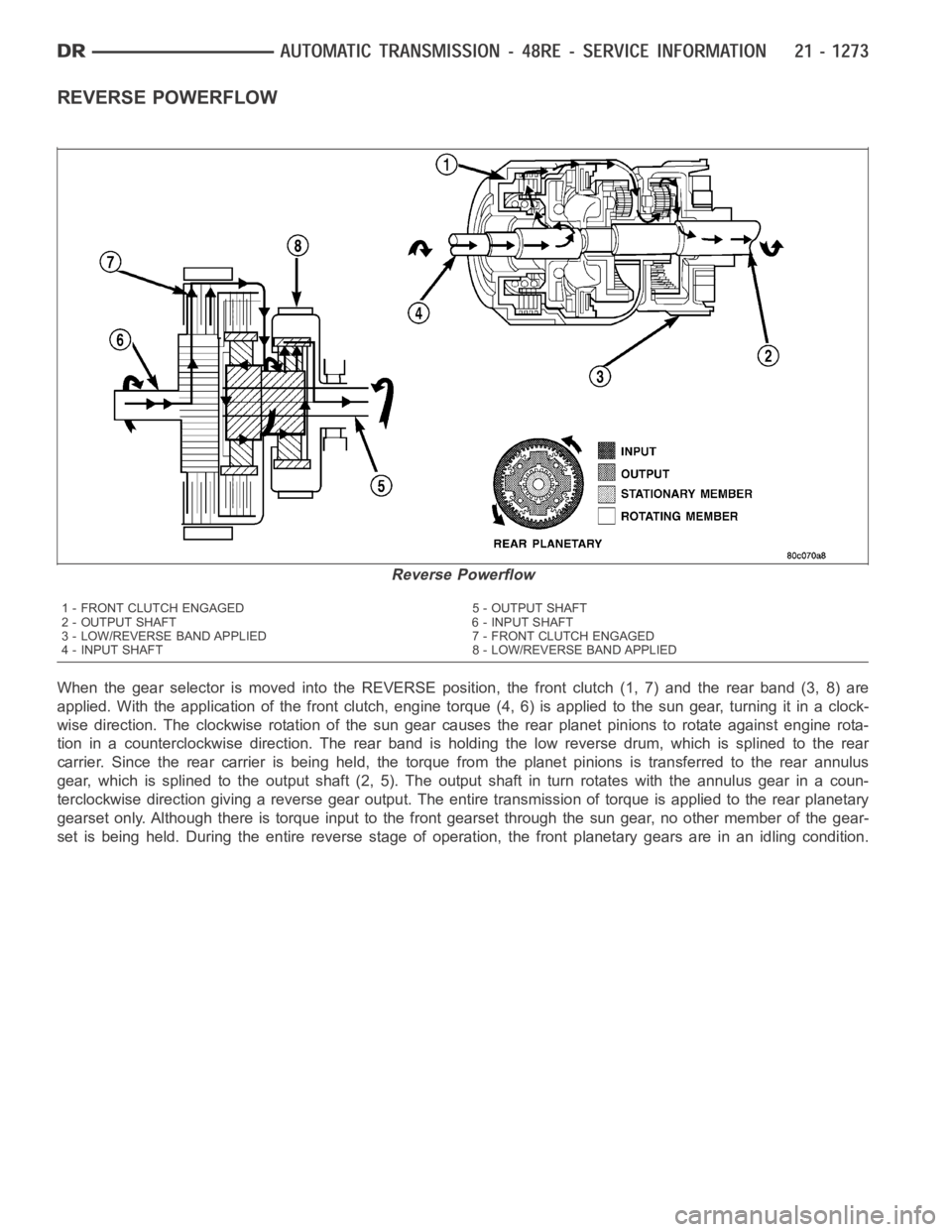
REVERSE POWERFLOW
When the gear selector is moved into the REVERSE position, the front clutch(1, 7) and the rear band (3, 8) are
applied. With the application of the front clutch, engine torque (4, 6) is applied to the sun gear, turning it in a clock-
wise direction. The clockwise rotation of the sun gear causes the rear planet pinions to rotate against engine rota-
tion in a counterclockwise direction. The rear band is holding the low reverse drum, which is splined to the rear
carrier. Since the rear carrier is being held, the torque from the planet pinions is transferred to the rear annulus
gear, which is splined to the output shaft (2, 5). The output shaft in turn rotates with the annulus gear in a coun-
terclockwise direction giving a reverse gear output. The entire transmission of torque is applied to the rear planetary
gearset only. Although there is torque input to the front gearset through the sun gear, no other member of the gear-
set is being held. During the entire reverse stage of operation, the front planetary gears are in an idling condition.
Reverse Powerflow
1 - FRONT CLUTCH ENGAGED 5 - OUTPUT SHAFT
2 - OUTPUT SHAFT 6 - INPUT SHAFT
3 - LOW/REVERSE BAND APPLIED 7 - FRONT CLUTCH ENGAGED
4 - INPUT SHAFT 8 - LOW/REVERSE BAND APPLIED
Page 3795 of 5267
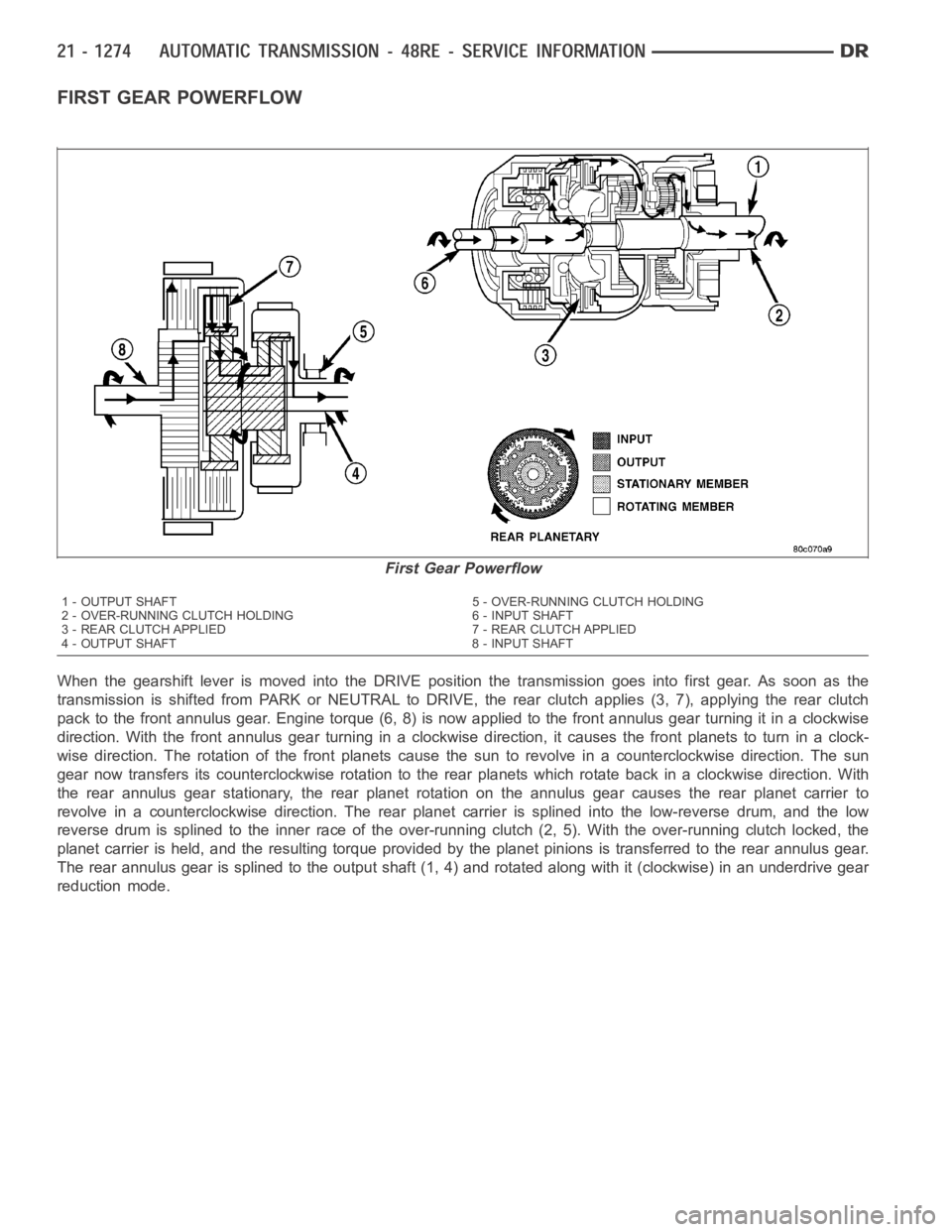
FIRST GEAR POWERFLOW
When the gearshift lever is moved into the DRIVE position the transmissiongoes into first gear. As soon as the
transmission is shifted from PARK or NEUTRAL to DRIVE, the rear clutch applies (3, 7), applying the rear clutch
pack to the front annulus gear. Engine torque (6, 8) is now applied to the front annulus gear turning it in a clockwise
direction. With the front annulus gear turning in a clockwise direction, it causes the front planets to turn in a clock-
wise direction. The rotation of the front planets cause the sun to revolve in a counterclockwise direction. The sun
gear now transfers its counterclockwise rotation to the rear planets which rotate back in a clockwise direction. With
the rear annulus gear stationary, the rear planet rotation on the annulus gear causes the rear planet carrier to
revolve in a counterclockwise direction. The rear planet carrier is splined into the low-reverse drum, and the low
reverse drum is splined to the inner race of the over-running clutch (2, 5).With the over-running clutch locked, the
planet carrier is held, and the resulting torque provided by the planet pinions is transferred to the rear annulus gear.
The rear annulus gear is splined to the output shaft (1, 4) and rotated alongwith it (clockwise) in an underdrive gear
reduction mode.
First Gear Powerflow
1 - OUTPUT SHAFT 5 - OVER-RUNNING CLUTCH HOLDING
2 - OVER-RUNNING CLUTCH HOLDING 6 - INPUT SHAFT
3 - REAR CLUTCH APPLIED 7 - REAR CLUTCH APPLIED
4 - OUTPUT SHAFT 8 - INPUT SHAFT